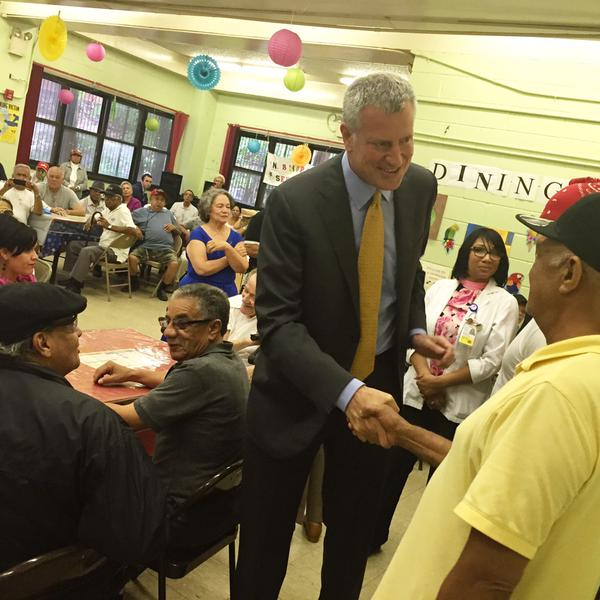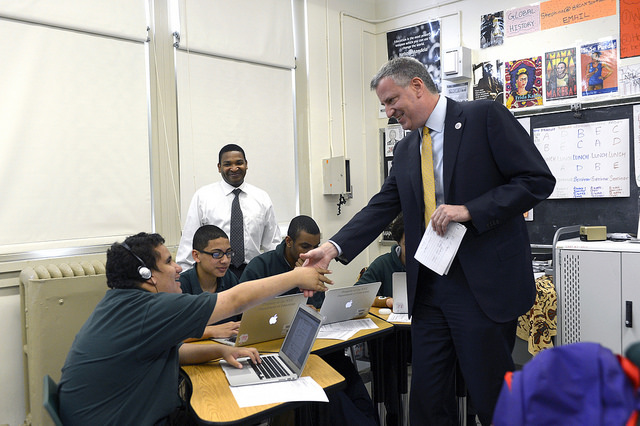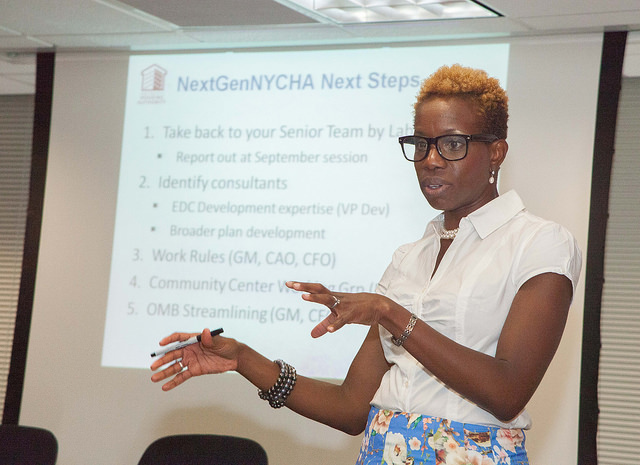Creating a Truly Age-Friendly NYC

Mayor de Blasio visits older New Yorkers (photo: @mayorsCAU)
Today marks the 25th anniversary of the International Day of Older Persons, established by the United Nations General Assembly to both raise awareness of issues affecting older people and commemorate the contributions that they have made to society.
Here in New York City, there's a lot to appreciate.
Older people have helped make New York City the incredible place it is today. They built our infrastructure, led social justice movements, made major advances in health care and technology, and fueled our thriving economy.
Mayor Bill de Blasio's platform for social justice and equity, including plans for improving pedestrian safety, increasing the affordable housing stock, facilitating access to the Internet, and renovating the city's parks, has the potential to improve older people's quality of life if they are effectively consulted and considered.
The mayor's recent reconstitution and convening of the Age-friendly NYC Commission to identify and address areas where additional work is needed across the public and private sectors is another step in the right direction. Age-friendly NYC is a one-of-a-kind public-private partnership between the Mayor's Office, the New York City Council, and The New York Academy of Medicine, of which NYAM and AARP are commission members.
About 1.4 million of New York City's 8.4 million residents are 60 or older. That's one in six people. By 2030, this population will grow to one in every five, and older people will outnumber school-aged children. This will be one of the most diverse groups of older people in the world (over half of all older New Yorkers were born outside of the United States).
Healthy, active, and engaged older people are assets to city life. They work, loyally support local businesses, care for spouses and grandchildren, and give back through high rates of volunteerism. The city, in turn, has a great deal to offer older residents, as it does for people of all ages: vibrant neighborhoods, great public transportation, walkability, shopping and commerce, rich cultural institutions, and high-quality health care and social services.
Yet, New York City can be a challenging place for older people to live. Expenses are high, and the poverty rate among older people is nearly 20 percent — significantly higher than the national average. Finding affordable and accessible housing is difficult, with two in every three people over 70 paying more than 30 percent of their income in rent. In many neighborhoods, older people restrict their activities because of crime and safety concerns, as well as difficulty getting around. This can lead to social isolation which is associated with poor health.
In fact, a recent AARP survey of New York City voters shows even more concern about affording rent and mortgage payments among the up-and-coming older New Yorkers – Generation X (64%) – than among Baby Boomers (59%), with even higher numbers of African-American (74%) and Hispanic (70%) Gen Xers and Baby Boomers concerned. And a majority of both generations also worries about being able to pay utility bills, with African-Americans' and Hispanics' concerns again higher.
A separate AARP survey of New York City adults 50 and older found that 90 percent want to stay in their homes as they age and 73 percent say promoting age-friendly living should be a top or high priority for elected officials. Sometimes simple low- or no-cost solutions, such as the strategic placement of a bench or the use of school buses to transport older people to grocery stores during school hours, can make older people's lives easier, fuller, and more satisfying. Age-friendly NYC is dedicated to doing just that — creating a New York City where people of all ages can live, work, and thrive.
Since its inception in 2008, some of the improvements made by Age-friendly NYC include a reduction in senior pedestrian fatalities, increased walkability through the addition of public seating, new programming for older people at parks, educational and cultural institutions, and a better consumer experience offered by many local businesses. We've also worked closely with architects, urban planners, librarians, small business owners, and lawyers, just to name a few, to raise awareness of age-related issues within their respective fields.
We are making great progress, but there is still much work to be done to protect the rights and meet the needs of older people, who often report feeling left out or experiencing age discrimination where they live and work. If we are lucky, we will all be old one day, and we will want to continue enjoying everything we've always loved about our city — exercising in the park, shopping at favorite stores, going to concerts, museums, and theaters, and socializing with family and friends. Today, on the International Day of Older Persons, let's recognize the strength of older people and commit to making New York City a place where people of all ages feel included and valued.
***
by Lindsay Goldman and Beth Finkel
Lindsay Goldman, LMSW, is Deputy Director, Healthy Aging, The New York Academy of Medicine
Beth Finkel, MSW, is New York State Director, AARP
Read more about Age-friendly NYC here
*note: this column has been updated from its original version to include more information from recent surveys
***
Have an op-ed idea or submission for Gotham Gazette? E-mail editor Ben Max: This email address is being protected from spambots. You need JavaScript enabled to view it.
Why Arts Educators Support Computer Science

Mayor de Blasio at a school visit (photo: Rob Bennett for the Mayor's Office)
Advocates for arts education support Mayor Bill de Blasio's proposal to expand access to computer science in city schools. Surprised? You shouldn't be.
Learning to code flexes many of the same creative and problem-solving muscles as participating in the visual and performing arts. In the arts and in computer science students often start with a blank slate and build something from nothing. The tools may be different, but the process of exploration, experimentation, and critical reflection is the same.
Fluency with technology is essential to many applied forms of 21st century art-making: music composition and production, graphic design and architecture, filmmaking, and animation. The earlier students become comfortable with advanced tools, the easier it becomes for them to translate the sounds and pictures of their imagination into tangible media: art.
Mayor de Blasio highlights the doors of opportunity in the technology sector. Openings in the creative industries (which thrive in New York City, the cultural capital of the world) increasingly require computer credentials. As artistically-minded students graduate into the working world, mastery of content-creating tools can be a prerequisite for making a living.
Most importantly, any step to de-emphasize rote, test-focused learning, and toward education of the whole child is entirely welcome. Well-taught computer science curriculum moves in the right direction, teaching students to think, engage, and create.
It's no coincidence that one of the school leaders cited for driving computer science in the schools - Ramon Gonzalez, the superstar principal of MS 223 in the Bronx - has also been a leader in integrating arts education throughout his curriculum.
In fact, the connections between computer science and arts education are driving the "STEM to STEAM" movement, which includes "arts" in the typical science, technology, engineering, and math acronym. Accordingly, The Center for Arts Education has developed curricula that address these connections.
To be sure, those who understand the essential role of arts education would be gravely disappointed if computer science electives pushed out required arts education courses. But, the mayor and schools Chancellor Carmen Farina have demonstrated a strong commitment to expanding access to arts education. Last year, the mayor and the City Council agreed to a historic four-year, $92-million expansion in funding for arts education that is already impacting the lives and educational opportunities of thousands of New York City students.
Some have noted the shortage of credentialed computer science teachers. That's a valid point—and makes the ten-year phase-in period of the de Blasio proposal look wise. We see a similar deficit in the supply of arts teachers. It's a topic for another day, but soon: re-invigorating the city's pipeline of credentialed instructors is essential.
Proponents of computer science instruction and arts education may seem like odd bedfellows, but we are joined in our commitment to teaching the whole child and preparing every child in every school for success in college, career, and life.
As Mayor de Blasio recently laid out his new education plans at Bronx Latin High School, he noted that computer science develops communication, collaboration, creativity, and critical thinking - the very same 21st century skills that quality arts education develops.
***
Lori Sherman is Deputy Director of The Center for Arts Education, a leading arts education provider and advocate. On Twitter @centerforartsed.
***
Have an op-ed idea or submission for Gotham Gazette? E-mail editor Ben Max: This email address is being protected from spambots. You need JavaScript enabled to view it.
A True, New NYCHA Development Plan

NYCHA Chair Olatoye, the author, at a NextGen meeting (via NYCHA on flickr)
Public housing has been an integral feature of New York City life since Fiorello La Guardia opened the doors of First Houses eighty years ago, and roughly five percent of the city's population lives in public housing today. As a landlord, NYCHA manages buildings, but our real service is to people— the 615,000 residents who live in our developments and our Section 8 voucher holders.
We are doing everything we can to ensure the long-term survival and health of public housing in New York City. This includes new, creative solutions to major challenges.
We face immense financial obstacles as NYCHA struggles to repair and maintain our buildings and grounds. We can no longer delay making difficult, critical choices about how we operate, how we are financed, and how we rebuild and rehabilitate our 328 developments. To avoid the fate of other housing authorities across the country, NYCHA must find innovative solutions to maintain and improve our properties.
Due in part to federal and state disinvestment, the city is investing more than ever to craft solutions that bring about real change. We are doing this because we recognize the simple truth that we have an ethical responsibility to provide and sustain affordable housing for our city's low-income populations.
Today, just 18 percent of the land on NYCHA's 328 developments is used to house residents. Using some of that land to develop new mixed-income housing can generate significant funds benefiting local and citywide NYCHA residents, as well as those in the surrounding community. We call these developments NextGen Neighborhoods because they provide the funding we need to create the safe, clean, connected communities that we envision in our ten-year strategic plan, NextGeneration NYCHA.
This isn't the first time NYCHA has proposed developing market-rate housing on our properties, but it is the first time resident engagement has been made integral to the process. And the first time an administration has pledged to ensure that just as many units of affordable housing are built as market rate housing.
This 50/50 model will ensure a significant percentage of the proceeds from the affordable and market-rate buildings will be provided to each development for residents to invest back into building new kitchens, fixing the root causes of leakage, and other priorities. The remaining funds will be funneled by NYCHA into making improvements across NYCHA's portfolio.
Our strategic plan aims to preserve this precious resource of public housing for the next generation of New Yorkers. NextGen Neighborhoods is just one of the fifteen initiatives we outlined in the plan to rebuild and repair our properties and sustain NYCHA for the long term.
[Related: Another Way of Looking at NYCHA Infill Development]
The funds we generate through NextGen Neighborhoods will be added to those generated from other strategies— such as our parking initiative, our commercial initiative, and our preservation initiative. None of these strategies work in a vacuum, they all work together as a comprehensive plan to get NYCHA's financial health in order, create more affordable housing, and invest in the Housing Authority and in the future of our city.
I've been clear that upon moving into this position, Mayor de Blasio charged me with the task of resetting the Authority's relationship with residents. We cannot do business as usual with our city's public housing, and expect to see substantive and lasting change.
Our new plan is not the infill proposal put forth by the previous administration— this is NYCHA working together with residents, with community members and advocates, and with elected officials to support the creation of mixed-income affordable housing on NYCHA property.
This is not privatization, but aggressive preservation— a strategy that is smart for residents and surrounding communities as well as NYCHA. We can generate money to repair and upgrade our developments while adding to the city's affordable housing stock, attracting new stores and services to neighborhoods, and producing income that can help NYCHA residents in other parts of New York. NYCHA will not compromise the rights of public housing tenants, unfairly evict tenants, or convert public housing units to market rate housing. We're in the business of housing people.
This is NYCHA moving forward, instead of maintaining the status quo. There is no better way to serve our residents.
***
Shola Olatoye is Chair of the New York City Housing Authority (NYCHA), landlord to over 600,000 residents of traditional public housing and Section 8 programs. She is on Twitter at @SholaOlatoye.
@GothamGazette
***
Have an op-ed idea or submission for Gotham Gazette? E-mail Editor Ben Max: This email address is being protected from spambots. You need JavaScript enabled to view it.




